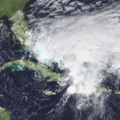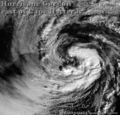Hurricane Gordon (1994) facts for kids
| Category 1 hurricane (SSHWS/NWS) | |

Hurricane Gordon near fullest power
|
|
| Formed | November 9, 1994 |
|---|---|
| Dissipated | November 21, 1994 |
| Highest winds | 1-minute sustained: 85 mph (140 km/h) |
| Lowest pressure | 980 mbar (hPa); 28.94 inHg |
| Fatalities | 1,147 direct |
| Damage | $514 million (1994 USD) |
| Areas affected | Nicaragua, Costa Rica, Jamaica, Haiti, Dominican Republic, Cuba, Florida, Georgia, South Carolina, North Carolina |
| Part of the 1994 Atlantic hurricane season | |
Hurricane Gordon was a powerful tropical storm that caused a lot of damage. It affected the Caribbean, Florida, and parts of North Carolina. This storm moved very slowly across the Caribbean.
Hurricane Gordon led to the deaths of over 1,100 people. Most of these deaths happened in Haiti and other central Caribbean islands like Jamaica and Cuba. Because the storm moved in a strange way, it was hard to predict where it would go. Gordon was the last storm of the 1994 Atlantic hurricane season. Even though it was only a hurricane for a short time, it was the second most expensive storm of that season.
Contents
Journey of Hurricane Gordon (Storm History)
The story of Hurricane Gordon began on November 8, 1994. A tropical wave formed near Costa Rica and became Tropical Depression Twelve. On November 10, it moved over land near Puerto Cabezas, Nicaragua.
Later that same day, it moved back into the Caribbean Sea. It then grew stronger and became Tropical Storm Gordon. On November 13, the storm made its first landfall near Kingston, Jamaica. Soon after, it made a second landfall in Guantánamo Bay, Cuba.
Gordon then moved along the northern coast of Cuba. It also passed by the southern islands of The Bahamas. On November 15, it made its third landfall in Key West, Florida.
The storm then turned towards the northeast. On November 16, it made its fourth landfall in Fort Myers, Florida. Gordon took about nine hours to cross Florida. After crossing the state, it moved into the Atlantic Ocean.
Gordon continued moving northeast until November 17. At this point, it became Hurricane Gordon. It was about 245 miles southeast of Cape Fear, North Carolina. Shortly after becoming a hurricane, its winds reached 85 miles per hour. It then moved very close to the coast of North Carolina.
After brushing North Carolina, Gordon weakened back into a tropical storm. It then started moving in a U-shaped path. Gordon weakened even more, becoming a tropical depression. On November 19, it made its fifth and final landfall near Vero Beach, Florida. Finally, on November 21, Gordon disappeared while over South Carolina.
What Happened: The Impact of Gordon
Impact in Haiti
The exact amount of damage in Haiti is not fully known. However, Hurricane Gordon caused about 1,122 deaths there. This high number was likely due to dangerous mudslides. It was also made worse by deforestation, which means many trees had been cut down. Without trees, the ground is less stable and more prone to mudslides.
Impact in Florida
Most of the money lost due to damage happened in Florida. The total damage in Florida was about $400 million. This was likely because Gordon crossed the state three different times. Each time it crossed, it caused more damage.
Why the Name Gordon Was Used Again
Even though Hurricane Gordon caused many deaths in Haiti, its name was not "retired." When a hurricane name is retired, it means it won't be used again because the storm was so deadly or damaging.
Since Gordon was not retired in 1994, the name has been used again. It was used for storms in 2000, 2006, 2012, and 2018. The name Gordon is expected to be used again in 2024.
|
Tropical cyclones of the 1994 Atlantic hurricane season |
||||||||||||||||||||||||||||
|
|
|||||||||||||||||||||||||||
|
|
||||||||||||||||||||||||||||
Images for kids
See also
 In Spanish: Huracán Gordon (1994) para niños
In Spanish: Huracán Gordon (1994) para niños





